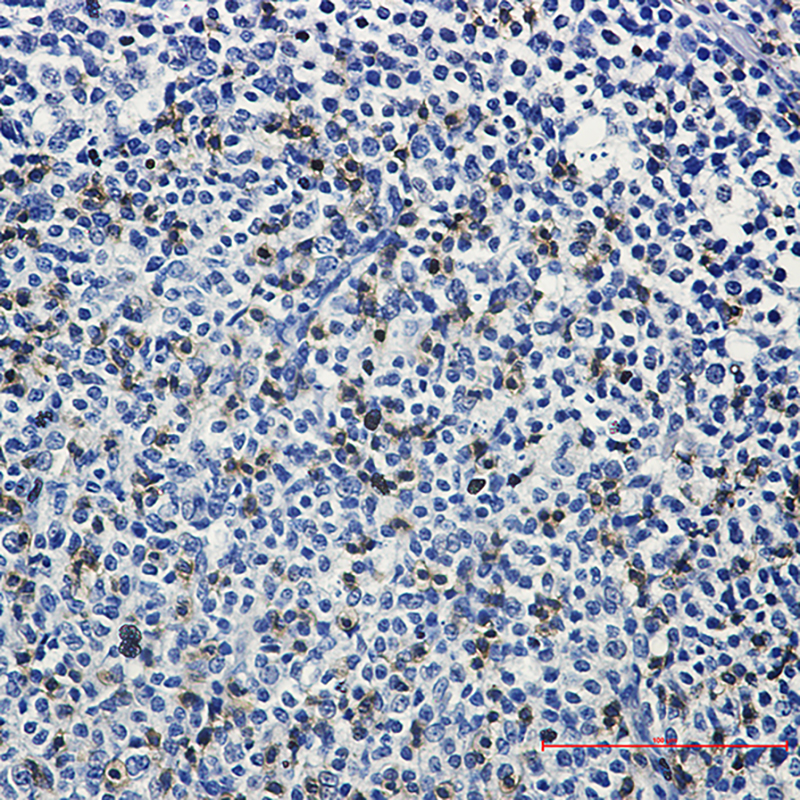

| WB | 1/500-1/1000 | Human,Mouse,Rat |
| IF | 1/20 | Human,Mouse,Rat |
| IHC | 1/50-1/100 | Human,Mouse,Rat |
| ICC | 技术咨询 | Human,Mouse,Rat |
| FCM | 咨询技术 | Human,Mouse,Rat |
| Elisa | 咨询技术 | Human,Mouse,Rat |
| Aliases | LAT; Linker for activation of T-cells family member 1; 36 kDa phospho-tyrosine adapter protein; pp36; p36-38 |
| Entrez GeneID | 27040 |
| WB Predicted band size | Calculated MW: 28 kDa; Observed MW: 36 kDa |
| Host/Isotype | Rabbit IgG |
| Antibody Type | Primary antibody |
| Storage | Store at 4°C short term. Aliquot and store at -20°C long term. Avoid freeze/thaw cycles. |
| Species Reactivity | Human |
| Immunogen | A synthetic peptide of human LAT |
| Formulation | Purified antibody in TBS with 0.05% sodium azide,0.05%BSA and 50% glycerol. |
+ +
以下是关于LAT抗体的参考文献示例(注:以下文献为示例性内容,实际文献需通过学术数据库查询):
---
1. **文献名称**:*LAT: A Critical Regulator of T-Cell Activation and Signaling*
**作者**:Samelson, L.E.
**摘要**:该综述系统阐述了LAT蛋白在T细胞受体(TCR)信号传导中的核心作用,包括其作为接头蛋白介导下游信号通路(如MAPK、PLCγ1激活)的机制,并讨论了针对LAT的抗体在实验研究中的应用,例如通过免疫沉淀分析LAT磷酸化修饰。
---
2. **文献名称**:*Autoantibodies Against LAT in Systemic Lupus Erythematosus*
**作者**:Li, Q.Z. et al.
**摘要**:研究报道了在系统性红斑狼疮(SLE)患者血清中发现抗LAT自身抗体,并通过ELISA和蛋白质印迹验证其特异性。结果提示LAT可能成为SLE的新型潜在生物标志物,其抗体水平与疾病活动度相关。
---
3. **文献名称**:*Targeting LAT in Autoimmune Encephalitis: A Mouse Model Study*
**作者**:Dalmau, J. et al.
**摘要**:通过构建LAT缺陷小鼠模型,研究发现LAT抗体可导致T细胞功能异常及中枢神经系统炎症,揭示了LAT在自身免疫性脑炎发病机制中的关键作用,为治疗提供了新靶点。
---
4. **文献名称**:*Functional Characterization of LAT-Specific Monoclonal Antibodies in TCR Signaling*
**作者**:Weiss, A. & Horejsi, V.
**摘要**:该研究开发了多种LAT特异性单克隆抗体,用于阻断或增强TCR信号通路,通过体外实验证明这些抗体可调控T细胞活化和增殖,为免疫调节治疗提供了工具。
---
**建议**:实际研究中,请通过PubMed、Web of Science等平台以关键词“LAT antibody”、“LAT autoantibody”或“LAT signaling”检索最新文献,并优先选择高影响力的期刊(如*Nature Immunology*、*Journal of Experimental Medicine*)。
Latent membrane protein 1 (LMP1)-associated transforming antibody (LAT antibody) refers to antibodies targeting LAT, a key adaptor protein in T-cell receptor (TCR) signaling. Discovered in the 1990s, LAT is a transmembrane protein critical for T-cell activation and immune response coordination. Upon TCR engagement, LAT is phosphorylated at conserved tyrosine residues, serving as a scaffold to recruit signaling molecules like PLC-γ1 and Grb2. which trigger downstream pathways (e.g., calcium flux, MAPK activation).
LAT antibodies, often used in research, help study TCR signaling dynamics, immune disorders, and LAT's role in pathologies. Mutations or dysregulation of LAT are linked to autoimmune diseases and immunodeficiencies. For instance, LAT-deficient mice exhibit blocked T-cell development, highlighting its importance in immune homeostasis. In clinical contexts, LAT antibodies may aid in diagnosing autoimmune conditions or monitoring therapies targeting T-cell pathways.
Notably, LAT is distinct from Epstein-Barr virus LMP1. though early studies occasionally caused nomenclature confusion. Research on LAT antibodies continues to advance insights into T-cell biology and therapeutic interventions for immune-related diseases.
×